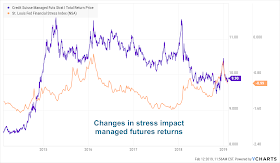I discovered from
reading an informative piece on managed futures and CTA's from HedgeNordic magazine that trend-followers
will produce "crisis alpha" but not "correction alpha". A
crisis is defined as a significant and extended downturn while a correction is
short-term drawdown. Unfortunately, one man's correction is another man's
crisis. All crises start and end as corrections.
Let's stop with the attempt to make trend-following something special during a crisis or that what trend-followers do is alpha. Trend-followers do not need the help. The value proposition for trend-following stands on its own.
We can make this simple. Managed futures trend-following, because it can take positions both long and short across a diversified set of markets, should do well in both up and down market trends. By construction, it will have low beta. This is an investment advantage.
This beta will not move to one in a crisis because it is not long-only and trades many markets. It will provide diversification in a crisis by the nature of the strategy especially against long-only equity benchmarks. This is an advantage.
If a market downturn is longer and more extreme, short trend positions will make money and profit relative to any long-only strategy. This is an advantage.
There is no prediction by trend-followers of when a crisis will occur. There is no need for a prediction. The success of trend-following is embedded in the basics of the strategy. There is no special alpha, crisis or otherwise. A trend-follower looks for price signals and is indifferent about the economic environment. This is an advantage.
The success of a trend-follower is consistent with the length and amplitude of a trend and the signal generation length. Long-term trend-followers need or exploit long-term trends. Short-term trend-followers need or exploit shorter-term trends. Crisis alpha is not function of manager skill but related to the time and intensity of the trend.
There is skill with finding the right model and right rules for risk management but that is independent of a crisis and more important for protecting principal when there are no trends. Making money during a crisis, large down equity moves, is a skill but the more relevant skill is being able to protection the profits generated between large market moves. A skill often overlooked is just following the model.
There is skill with finding the right model and right rules for risk management but that is independent of a crisis and more important for protecting principal when there are no trends. Making money during a crisis, large down equity moves, is a skill but the more relevant skill is being able to protection the profits generated between large market moves. A skill often overlooked is just following the model.
Stop with the crisis alpha and go back to basics for why this strategy will do well when long-only managers will suffer. The value of trend-following is its simplicity not complexity. It is an effective investment process based on following prices regardless of what you may call the environment. It may not be "alpha", but it is works by utilizing systematic skill.




























